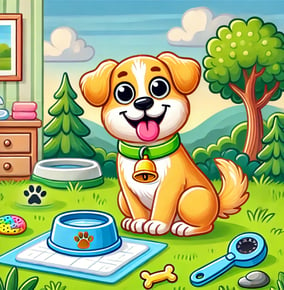I believe in educating dog owners about their breed, unlocking new levels of understanding, and taking that exciting next step together!
Master Potty Training: 10 Different Ways to Train Your Dog Like a Pro
Potty training your dog doesn’t have to feel like a chaotic game of “Guess the Puddle.” This guide spills the beans (but not on your carpet) on proven methods to make the process easier. From scheduled training that turns your dog into a bathroom clock to crate training that taps into their natural neat-freak instincts, there’s a method for every pup and lifestyle. Got an apartment dog? Try pad training or even litter boxes. Want your dog to ring a doorbell for potty time? Bell training has you covered. With options like command training, supervised potty patrol, and even clicker tricks, this guide helps you tackle the job with humor, patience, and plenty of treats. Soon, your dog will be a potty pro, and your floors will thank you!
POTTY TRAINING
Tiffany Sandquist
12/25/20243 min read


10 Different Ways to Potty Train Your Dog (and Why They Work)
Potty training your dog doesn’t have to be a battle of wills or a guessing game. With the right method tailored to your pup’s personality, age, and lifestyle, you can teach them to do their business where they’re supposed to—and save your floors in the process. Here are 10 effective ways to potty train your dog, why they work, and which dogs they’re best suited for.
1. Scheduled Training
Why It Works: Dogs thrive on routine. By establishing a consistent schedule for feeding, potty breaks, and playtime, you align their natural rhythms with a predictable routine, making potty training easier for both of you.
Best For: Puppies and adult dogs of all breeds.
Key Tips: Stick to regular feeding times and take your dog out first thing in the morning, after meals, naps, playtime, and before bed. Reward them with treats or praise when they succeed.
2. Crate Training
Why It Works: Dogs instinctively avoid soiling their sleeping area, so a crate helps teach them bladder control.
Best For: Puppies and dogs new to potty training.
Key Tips: Choose a crate that’s just big enough for your dog to stand and turn around. Let them out for frequent potty breaks and reward them for going outside. Avoid leaving them in the crate for too long.
3. Pad or Paper Training
Why It Works: This method provides a designated indoor spot for bathroom needs, teaching your dog where it’s acceptable to go.
Best For: Apartment dwellers, small dogs, and dogs with limited outdoor access.
Key Tips: Place pads or newspapers in a consistent location. Gradually move them closer to the door or outside if transitioning to outdoor potty training.
4. Bell Training
Why It Works: Dogs learn to associate ringing a bell with going outside, giving them a clear way to communicate their needs.
Best For: Dogs with basic potty training who need help signaling when they need to go out.
Key Tips: Hang a bell by the door, encourage your dog to nudge it before potty breaks, and immediately take them outside. Reward them for going in the right spot.
5. Command Training
Why It Works: Verbal commands create a strong association between the cue and the desired action, making bathroom behavior clear.
Best For: All dogs, especially those needing structured guidance.
Key Tips: Use a simple phrase like “Go potty” consistently. Say it as they start going and reward them afterward. Over time, they’ll learn to respond to the command.
6. Supervised Training
Why It Works: Close supervision helps you catch accidents before they happen and immediately redirect your dog to the right spot.
Best For: Puppies and newly adopted dogs.
Key Tips: Keep your dog within sight using leashes or baby gates. Watch for signs like sniffing or circling, and guide them outside promptly. Praise successes generously.
7. Clicker Training
Why It Works: The clicker marks the exact moment your dog succeeds, reinforcing the behavior with precision.
Best For: Dogs familiar with clicker training or owners who already use this method for other behaviors.
Key Tips: Use the clicker when your dog starts to go in the correct spot, then follow with treats and praise. Consistency is key to building the association.
8. Outdoor-Only Training
Why It Works: Focusing exclusively on outdoor bathroom habits establishes clear boundaries from the start.
Best For: Homes with easy access to a yard or outdoor space.
Key Tips: Take your dog outside for all potty breaks. Use a consistent spot and command to reinforce the habit. Reward every success to make the behavior stick.
9. Litter Box Training
Why It Works: A dog-friendly litter box offers a convenient indoor solution for small breeds or dogs with mobility challenges.
Best For: Small dogs, senior dogs, or households with limited outdoor options.
Key Tips: Introduce the litter box in a quiet, consistent location. Encourage your dog to use it with treats and praise. Clean it regularly to keep the area appealing.
10. Target Training
Why It Works: Training your dog to use a specific outdoor spot creates a clear, reliable potty area.
Best For: Dogs with access to a yard or other outdoor spaces.
Key Tips: Lead your dog to the chosen spot consistently. Use a command to encourage them to go there. Reward successes and reinforce the habit over time.
Choosing the Right Method
Each dog is unique, and the best potty training method depends on their age, size, breed, and environment. Often, a combination of techniques—like crate training paired with a consistent schedule—can deliver the best results. Whatever method you choose, consistency, patience, and positive reinforcement are the keys to success.
With these 10 strategies in your toolkit, you’ll be well on your way to a potty-trained pup and a cleaner, happier home!

Sit Happens Here
Transforming lives through dog training excellence.
Contact Us
971-218-9622
© 2024. All rights reserved.
